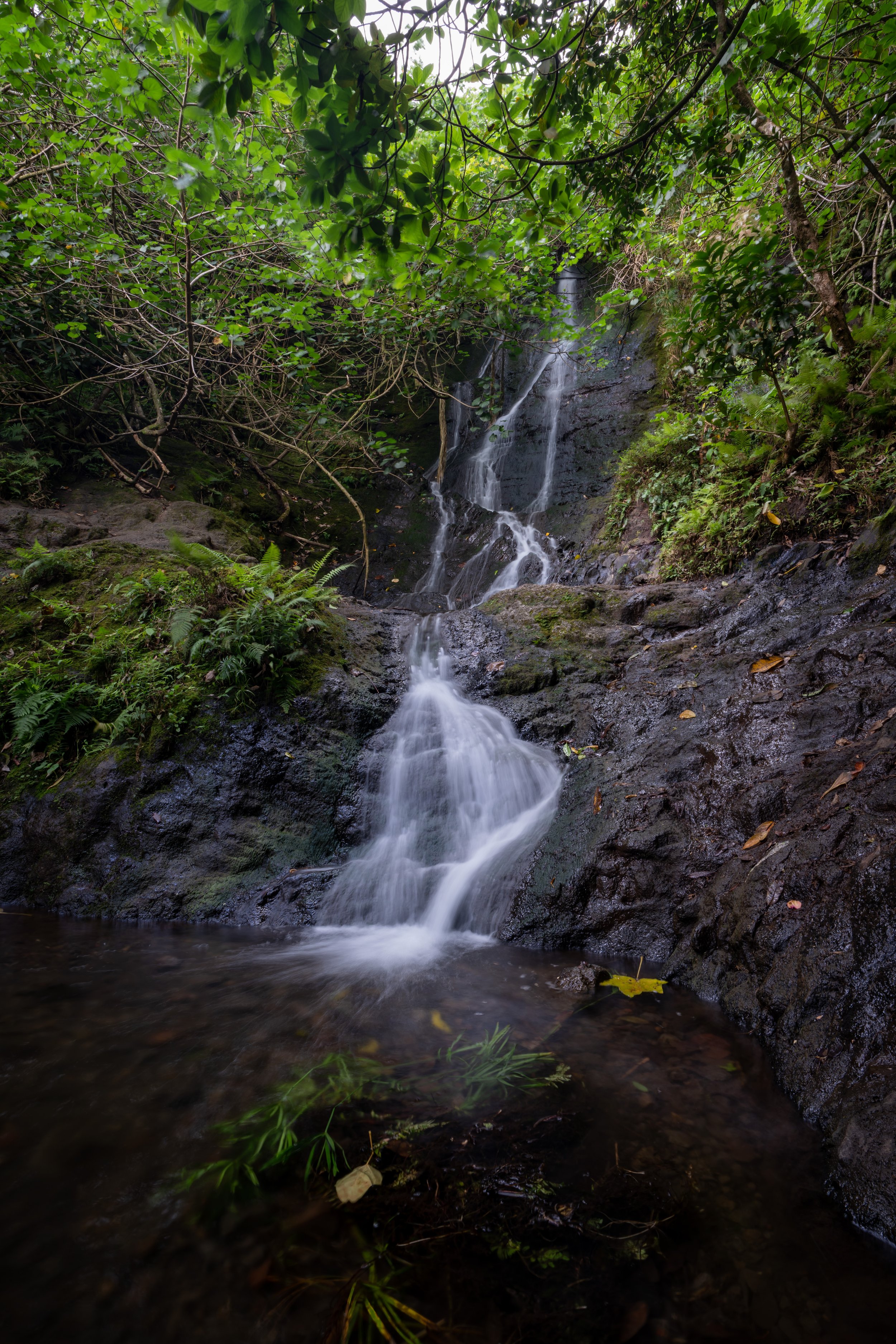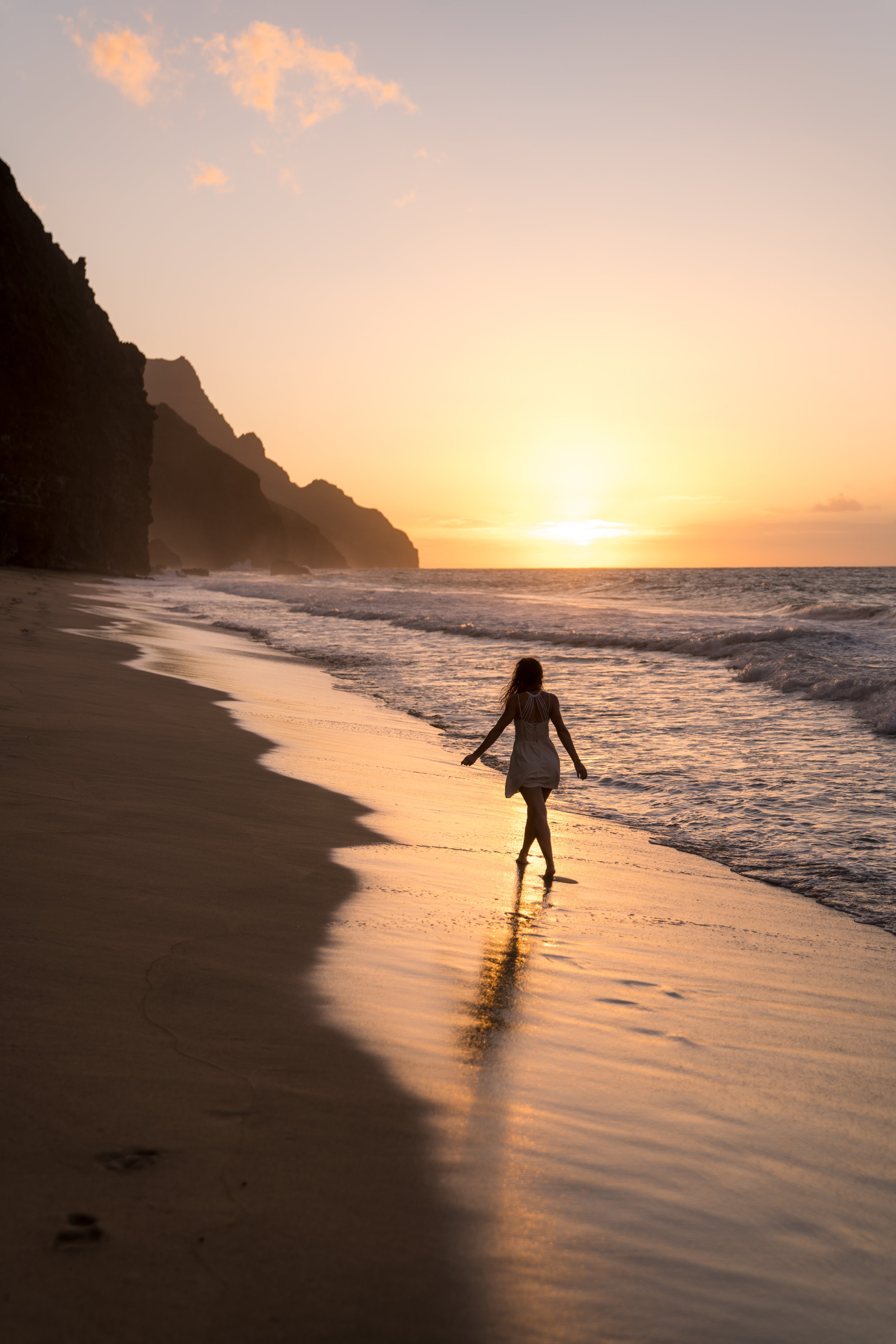Hiking the ʻAihualama Falls Trail at Lyon Arboretum on Oʻahu, Hawaiʻi
Distance: 1.3 miles / 2.1 km
The ʻAihualama Falls Trail in Mānoa Valley on Oʻahu is an easy out-and-back hike through the Harold L. Lyon Arboretum, a research unit of the University of Hawaiʻi that has a special focus in rare native Hawaiian plant cultivation.
That said, ʻAihualama Falls is truly the culmination of the whole arboretum experience, as the waterfall at the end of the trail is the furthest point that visitors can reach on the trail.
With that in mind, the distance above is only the shortest possible route to ʻAihualama Falls, which I mention because it’s most common to hike a bit further by exploring any one of a number of different side trails through the botanical garden—much like the Waimea Valley Trail on Oʻahu’s North Shore.
Lyon Arboretum (ʻAihualama Falls) Reservations
All those interested visiting Lyon Arboretum are required to book a free advanced reservation before arriving.
Book Here: Lyon Arboretum Reservations
How Bad are the Mosquitoes?
Compared to the neighboring Mānoa Falls Trail, the mosquitoes throughout Lyon Arboretum and the ʻAihualama Falls Trail are pretty bad, which is why I highly recommend wearing long sleeves and hiking pants for a more enjoyable experience.
ʻAihualama Falls Trailhead Parking
Parking the ʻAihualama Falls Trail is not the same as Mānoa Falls. Rather, free parking is included with your Lyon Arboretum reservation.
Simply let the Mānoa Falls parking attendant know about your Lyon Arboretum reservation when you arrive at the first parking area, and they will let you through at no cost.
Google Maps Directions: Lyon Arboretum
My Hawaiʻi Hiking Checklist
Osprey 3L Water Bladder - The Osprey 3L water bladder is the most universal hiking and backpacking water bladder on the market, and it’s my go-to because of the slide-off seal that allows it to be quickly filled from the top. Additionally, individual parts are easily replaceable, such as the bite valve.
Blister / Heel Protectors - I swear by these cheap, amazing heel protectors to prevent blisters for nearly every kind of hiking and backpacking that I do!
Black Diamond Headlamp - Personally, I recommend the Black Diamond Storm because it is one of the brightest, lightest, and longest-lasting headlamps on the market—and trust me, the weight-to-battery-life ratio really does matter!
Hiking / Trail Running Shoes - Depending on the type of trail, I prefer to use either the Keen Targhee for longer, more rugged hiking or the HOKA Zinal Trail-Running Shoe for lighter, less intense trails. In either case, both have been amazing to me for many years across countless environments, and both can be found in men’s and women’s sizes. - (Men’s Keen / Women’s Keen) (Men’s HOKA / Women’s HOKA)
Waterproof Rain Shell - You never know when it may rain, and I’ve learned over the years that a rain shell is far better than a rain jacket. By this, I mean that it’s best to have something that the water will roll right off of, which is why I recommend the Patagonia Torrentshell 3L available in both men’s and women’s sizes.
High SPF Sunscreen - Packing high-SPF sunscreen is a must for long days outside!
Hiking the ʻAihualama Falls Trail
Lyon Arboretum Visitor Center
All guests are required to sign in at the visitor center before visiting the arboretum/ trail.
From the visitor center, you can either continue walking through the native Hawaiian plant section or turn back toward the parking lot to take the fastest route to ʻAihualama Falls.
I personally recommend hiking the extra 0.1 miles (0.2 km) through the native Hawaiian section because it’s a much nicer hike than simply following the main trail.
The photos below on the left show the main trail, while the photos on the right show the native Hawaiian plant garden.
Main Trail
Native Hawaiian Garden
ʻAihualama Falls Trail
At this point, both routes come together for the rest of the trail to ʻAihualama Falls.
Throughout the trail, there will be a variety of side trails that lead through different sections of the arboretum, which you can follow using the map available from the visitor center.
Hawaiian Section
If there’s any section that I recommend the most, it’s the native Hawaiian plant section.
Here, you can see a ton of different native Hawaiian plants that are both common and very rare in nature.
Additionally, the views from the upper portion of the Hawaiian section are worth the visit alone. From there, you can see numerous waterfalls across the valley, which I have a photo of at the end.
Stay left to keep on the main trail.
Go right to stay on the ʻAihualama Falls Trail.
ʻAihualama Falls
The trail ends at the beautiful ʻAihualama Falls, which may have more or less water depending on the amount of rain Mānoa Valley has received recently.
What’s the Trail Past ʻAihualama Falls?
I do not recommend taking the trail past ʻAihualama Falls.
While it is possible to continue hiking through Mānoa Valley and end back up at the beginning, the route is very confusing and not well marked.
I have hiked extensively across the back of Mānoa Valley to know that there is not a great way to describe all of the trails back there.
It’s very likely that you could become lost.
Native Plants at Lyon Arboretum
Lyon Arboretum is an amazing place to learn about native Hawaiian plants because the arboretum is tasked with maintaining and propagating such a large collection of both common and very rare species.
Usually, I list out a variety of native plants that you can expect to see, but I think that’s really what the tour is for.
If you want to learn more about native Hawaiian plants, both at Lyon Arboretum and across Hawaiʻi, check out my separate post where I share all of my observations from different locations throughout the islands
Read My Separate Post: Native Hawaiian Plant Guide
More Oʻahu Adventures
If you’re interested in reading about some more amazing Oʻahu adventures, check out my separate posts below!
Best Hotels & Restaurants in Waikīkī
If you’re trying to decided where to stay on Oʻahu, check out my top 10 list for the best resorts and restaurants in Waikīkī.
I break down what makes one hotel a better choice over another, so that you can find the best fit for your stay on the island.
Read My Separate Post: Best Waikīkī Hotels & Restaurants
HNL Airport-Hotel Shuttle
Prices on ride-share apps like Uber/ Lyft cannot beat the price of booking your hotel shuttle prior to arrival. I say this because there are additional fees for ride-share airport pick-ups at Honolulu Airport (HNL), which is why I recommend booking your transportation in advance using the options below.
Additionally, the last option below will go as far as the Ko ʻOlina Resorts on the West Side and Turtle Bay on Oʻahu’s North Shore!
Best Way to Book Rental Cars!
I travel quite a bit, and I know firsthand that finding a good rental car deal can be a challenge, but that’s why I recommend comparing all of your options with Discover Cars.
In short, Discover Cars is a well-known, reputable business that allows you to search for the best deal across companies, and they have the best full-refund cancellation policy I’ve ever seen, valid up to 72, or sometimes even 48, hours prior to your reservation!
Book Here: Discover Cars
Visiting Other Islands
If you are visiting Oʻahu or heading to another island, check out some of my personal recommendations for Oʻahu, Maui, Kauaʻi, Molokai, Lānaʻi, and Hawaiʻi Island (Big Island) in these separate posts.
If you’re trying to decide which island is right for your visit, check out my overview about each island in the post below.
Read My Separate Post: What is the Best Hawaiian Island to Visit?
What is the Best Time of Year to Visit Hawaiʻi?
The weather in Hawaiʻi can often appear to be warm and beautiful throughout the year, but in my experience, there is a lot more to consider when planning what time of year to visit the islands, such as what island you are considering, what sides of each island do you plan to stay, what activities are you most interested in, the wildlife, and countless other nuanced variables that can all impact the type of trip you can expect to have.
For these reasons, I highly recommend reading through my separate article to not only understand my thoughts regarding the best time of year to come to Hawaiʻi but also what you need to consider based on the time of year that you plan to visit.
Read My Separate Post: What is the Best Time of Year to Visit Hawaiʻi?
10 Best Tours & Excursions on Oʻahu
There are a lot of different tour options to choose from on Oʻahu, but to make it easier to decide, I made a list of my favorite tours because some things simply are better with a local guide!
Read My Separate Post: Best Tours on Oʻahu
Safety
All hikes in Hawaiʻi should not be compared to trails outside of the islands, and hikers should exercise due caution on every adventure, given that many are extremely dangerous.
By this, I mean that Hawaiʻi is known for hot, humid weather, steep, dramatic, and unstable cliffs, and flash floods, which can occur without warning. Therefore, it is important that you check the local forecast, understand the physical condition of your entire group, and pack sufficient food and water before attempting any adventure.
Disclaimer
All information provided on this blog is for informational purposes only and is not intended to be a substitute for information or advice from qualified professionals or managing agencies.
Noah Lang Photography LLC makes no representations or warranties regarding the accuracy or completeness of the information provided here, and readers should use their own discretion, judgement, and seek professional advice where it is appropriate.
Furthermore, Noah Lang Photography LLC shall not be held responsible for any injuries, lost individuals, or legal issues arising from the use of information provided on this website, and if applicable, the above safety disclaimer should be referenced to provide a generic overview of the risks involved.
All said, the content on this blog is for the sole use of Noah Lang Photography LLC, and unauthorized use or reproduction of this content is strictly prohibited.
Disclosure
This post is not sponsored.
However, some of the links in this post are affiliate links, which means that I may earn a small commission if a purchase is made through one of those links. This commission comes at no additional cost to you, and I only recommend products that I personally use and believe will add value to my readers. Thank you for your support, which enables me to continue creating more!
To read the full privacy policy, click here.

About This Blog
Noah Lang Photography, also known as @noahawaii, is 100% reader-supported!
I do not accept guest articles or sponsored content of any kind on my blog, which is why, if you enjoy the outdoor and travel content I create, please consider buying me a coffee!
I appreciate your support, which helps me continue to keep this blog alive!






























